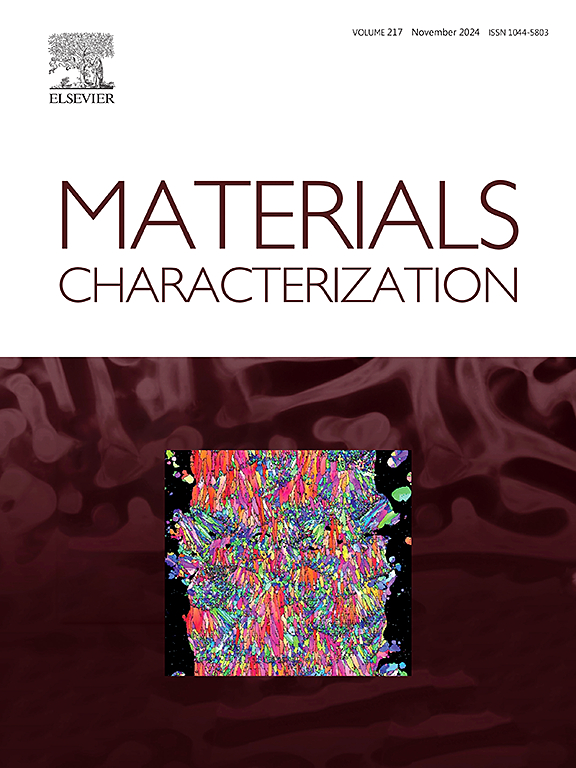近α MgLi合金室温动态应变时效:位错亚结构的研究
IF 4.8
2区 材料科学
Q1 MATERIALS SCIENCE, CHARACTERIZATION & TESTING
引用次数: 0
摘要
铸态Mg-5.5 Li-0.5 Y合金在不同应变速率下进行拉伸。只有当样品在10−4 s−1下变形时,才能观察到带有几个显著滴的锯齿状流动。流动应力的突然下降主要发生在应变低于0.03时,而塑性失稳在较大应变时消失。应变速率跳变试验表明,该合金在10−4 s−1时表现出负应变速率敏感性,这是动态应变老化(DSA)的标志。流变行为的差异表明MgLi合金的变形行为在很大程度上取决于应变速率。在不同应变速率下变形的样品中,位错的形态是不同的。DSA样品的位错密度相对较低,大多数位错为基底<; >; 滑移。DSA促进位错的缓慢爬升,爬升引起位错转移到另一个基面并进一步滑动,形成一系列位错弓和偶极子。除了工作爬升外,层错的形成是10−4 s−1变形试样的另一个特征。溶质原子在层错处偏析,这对位错的可动性有很强的钉住作用。当试样张力为10−4 s−1时,滑动层的存在导致了较高的强度和加工硬化率。本文章由计算机程序翻译,如有差异,请以英文原文为准。
Dynamic strain aging at the room temperature of near-α MgLi alloy: A study of dislocation substructures
As-casted Mg-5.5 Li-0.5 Y alloy was tension at different strain rates. A serrated flow with several remarkable drops was only observed when samples deformed at 10−4 s−1. The sudden drop of flow stress mainly existed in the strain lower than 0.03, and the plastic instability disappeared at the larger strain. The strain rate jump test proved that the alloy exhibited a negative strain rate sensitivity at 10−4 s−1, which is a sign of dynamic strain aging (DSA). The difference in flow behavior indicates the deformation behavior of Mg![]() Li alloys largely depends on strain rate. The dislocation configuration in the samples deformed at different strain rates is different. The dislocation density of the DSA sample is relatively low and most of the dislocations were basal <a > slip. DSA promoted jog climb of dislocation and the climb induced the dislocation transferred to another basal plane and further glide, which forms a series of dislocation bows and dipoles. Besides the job climb, the formation of stacking faults is another characteristic of the sample deformed at 10−4 s−1. The solute atoms are segregated at the stacking faults, which shows a strong pinning effect on dislocation movability. Inhabitation of the glide induced a high strength and work hardening rate when the sample tension was at 10−4 s−1.
Li alloys largely depends on strain rate. The dislocation configuration in the samples deformed at different strain rates is different. The dislocation density of the DSA sample is relatively low and most of the dislocations were basal <a > slip. DSA promoted jog climb of dislocation and the climb induced the dislocation transferred to another basal plane and further glide, which forms a series of dislocation bows and dipoles. Besides the job climb, the formation of stacking faults is another characteristic of the sample deformed at 10−4 s−1. The solute atoms are segregated at the stacking faults, which shows a strong pinning effect on dislocation movability. Inhabitation of the glide induced a high strength and work hardening rate when the sample tension was at 10−4 s−1.
求助全文
通过发布文献求助,成功后即可免费获取论文全文。
去求助
来源期刊

Materials Characterization
工程技术-材料科学:表征与测试
CiteScore
7.60
自引率
8.50%
发文量
746
审稿时长
36 days
期刊介绍:
Materials Characterization features original articles and state-of-the-art reviews on theoretical and practical aspects of the structure and behaviour of materials.
The Journal focuses on all characterization techniques, including all forms of microscopy (light, electron, acoustic, etc.,) and analysis (especially microanalysis and surface analytical techniques). Developments in both this wide range of techniques and their application to the quantification of the microstructure of materials are essential facets of the Journal.
The Journal provides the Materials Scientist/Engineer with up-to-date information on many types of materials with an underlying theme of explaining the behavior of materials using novel approaches. Materials covered by the journal include:
Metals & Alloys
Ceramics
Nanomaterials
Biomedical materials
Optical materials
Composites
Natural Materials.
 求助内容:
求助内容: 应助结果提醒方式:
应助结果提醒方式:


